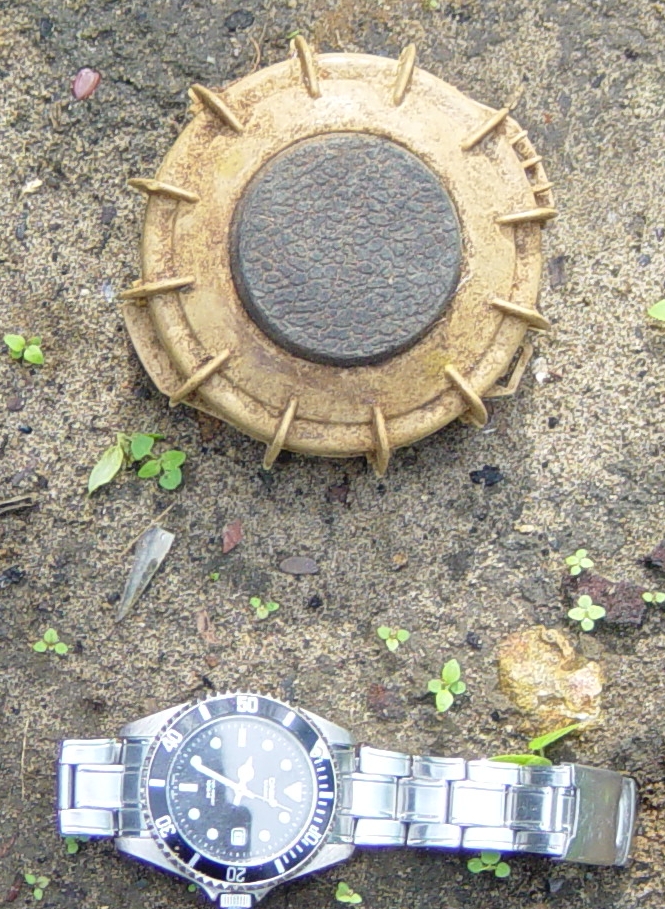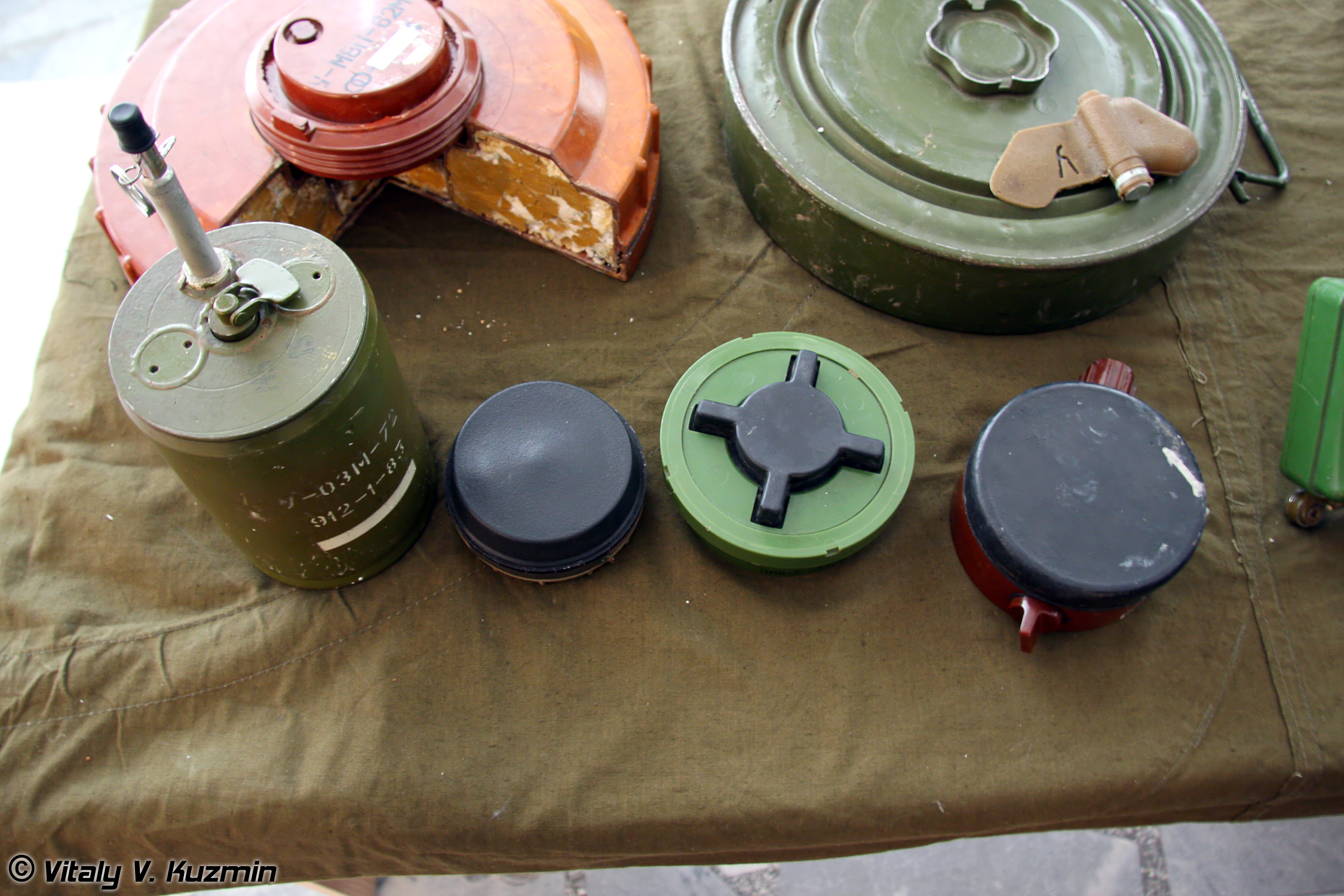|
PM-79 Mine
The PM-79 is a small, circular Bulgarian blast-resistant anti-personnel mine, superficially similar to the Russian PMN. The mine uses a unique trigger design; on the top of the mine, beneath a thin rubber cover is a dish shaped pressure plate. Pressure on the outer rim of the dish shaped plate levers up a central post, which triggers the mine. The mine also incorporates a mechanical arming delay using a pin cutting through a thin lead strip. The mine arms in between two minutes and four hours depending on the temperature. The mine has been withdrawn from Bulgarian service, although it is sometimes found in parts of Asia. Specifications * Diameter: * Height: * Weight: * Explosive content: TNT Troponin T (shortened TnT or TropT) is a part of the troponin complex, which are proteins integral to the contraction of skeletal and heart muscles. They are expressed in skeletal and cardiac myocytes. Troponin T binds to tropomyosin and helps ... * Operating pressure: or more Ref ... [...More Info...] [...Related Items...] OR: [Wikipedia] [Google] [Baidu] |
Bulgaria
Bulgaria, officially the Republic of Bulgaria, is a country in Southeast Europe. It is situated on the eastern portion of the Balkans directly south of the Danube river and west of the Black Sea. Bulgaria is bordered by Greece and Turkey to the south, Serbia and North Macedonia to the west, and Romania to the north. It covers a territory of and is the tenth largest within the European Union and the List of European countries by area, sixteenth-largest country in Europe by area. Sofia is the nation's capital and List of cities and towns in Bulgaria, largest city; other major cities include Burgas, Plovdiv, and Varna, Bulgaria, Varna. One of the earliest societies in the lands of modern-day Bulgaria was the Karanovo culture (6,500 BC). In the 6th to 3rd century BC, the region was a battleground for ancient Thracians, Persians, Celts and Ancient Macedonians, Macedonians; stability came when the Roman Empire conquered the region in AD 45. After the Roman state splintered, trib ... [...More Info...] [...Related Items...] OR: [Wikipedia] [Google] [Baidu] |
Blast Resistant Mine
A blast resistant mine is a landmine (intended for anti-tank or anti-personnel purposes) with a fuze which is designed to be insensitive to the shock wave from a nearby explosion. This feature makes it difficult or impossible to clear such mines using explosive minefield breaching techniques. As a result, the process of clearing minefields is slower and more complex. Blast resistance can be achieved in a number of ways. Pressure blast resistant fuzes In pressure fuzed landmines this is achieved by having the fuze react differently based on the duration of the pressure impulse. For example, a number of Italian landmines like the VS-1.6 use an air system, where air is forced through a small hole into an air bladder, the inflation of which rotates a locking collar and releases the striker into the detonator. The sudden impulse from impact or explosion does not have sufficient duration to inflate the bladder and rotate the locking collar, whereas steady pressure from a vehicle's wheel ... [...More Info...] [...Related Items...] OR: [Wikipedia] [Google] [Baidu] |
Anti-personnel Mine
An anti-personnel mine or anti-personnel landmine (APL) is a form of land mine, mine designed for use against human, humans, as opposed to an anti-tank mine, which target vehicles. APLs are classified into: blast mines and fragmentation mines; the latter may or may not be a bounding mine. APLs are often designed to injure and mutilation, maim, not kill, their victims to overwhelm the logistical (mostly medical) support system of enemy forces that encounter them. Some types of APLs can also damage the tracks on armoured vehicles or the tires of wheeled vehicles. The International Campaign to Ban Landmines has sought to ban mines and destroy stockpile. For this purpose, it introduced in 1997 the Ottawa Treaty, which has not yet been accepted by over 30 states and has not guaranteed the protection of citizens against APLs planted by non-state armed groups. Use Anti-personnel mines are used in a similar manner to anti-tank mines, in static "mine fields" along national borders o ... [...More Info...] [...Related Items...] OR: [Wikipedia] [Google] [Baidu] |
PMN Mine
The PMN () series of blast anti-personnel mines were designed and manufactured in the Soviet Union. They are one of the most widely used and commonly found devices during demining operations. They are sometimes nicknamed "black widow" because of their dark casings. PMN-1 The design of the PMN-1 mine dates from the late 1950s. It is particularly deadly because it contains an unusually large explosive filling when compared to most other anti-personnel landmines. For comparison, most anti-personnel blast mines (e.g. the VS-50 mine, VS-50) contain around of high explosive, which typically destroys all or part of a victim's foot. In marked contrast, a PMN-1 contains of explosive which can easily destroy a victim's entire leg (frequently requiring amputation high above the knee) in addition to inflicting severe injuries on the adjacent limb, which may also require some form of amputation due to blast injury. The majority of anti-personnel mine victims (e.g. those who step on an M14 mi ... [...More Info...] [...Related Items...] OR: [Wikipedia] [Google] [Baidu] |
Trinitrotoluene
Troponin T (shortened TnT or TropT) is a part of the troponin complex, which are proteins integral to the contraction of skeletal and heart muscles. They are expressed in skeletal and cardiac myocytes. Troponin T binds to tropomyosin and helps position it on actin, and together with the rest of the troponin complex, modulates contraction of striated muscle. The cardiac subtype of troponin T is especially useful in the laboratory diagnosis of heart attack because it is released into the blood-stream when damage to heart muscle occurs. It was discovered by the German physician Hugo A. Katus at the University of Heidelberg, who also developed the troponin T assay. Subtypes * Slow skeletal troponin T1, TNNT1 (19q13.4, ) * Cardiac troponin T2, TNNT2 (1q32, ) * Fast skeletal troponin T3, TNNT3 (11p15.5, ) Reference values The 99th percentile cutoff for cardiac troponin T (cTnT) is 0.01 ng/mL. The reference range for the high sensitivity troponin T is a normal 52 ng/L. Backgr ... [...More Info...] [...Related Items...] OR: [Wikipedia] [Google] [Baidu] |
Anti-personnel Mines
An anti-personnel mine or anti-personnel landmine (APL) is a form of land mine, mine designed for use against human, humans, as opposed to an anti-tank mine, which target vehicles. APLs are classified into: blast mines and fragmentation mines; the latter may or may not be a bounding mine. APLs are often designed to injure and mutilation, maim, not kill, their victims to overwhelm the logistical (mostly medical) support system of enemy forces that encounter them. Some types of APLs can also damage the tracks on armoured vehicles or the tires of wheeled vehicles. The International Campaign to Ban Landmines has sought to ban mines and destroy stockpile. For this purpose, it introduced in 1997 the Ottawa Treaty, which has not yet been accepted by over 30 states and has not guaranteed the protection of citizens against APLs planted by non-state armed groups. Use Anti-personnel mines are used in a similar manner to anti-tank mines, in static "mine fields" along national borders o ... [...More Info...] [...Related Items...] OR: [Wikipedia] [Google] [Baidu] |


